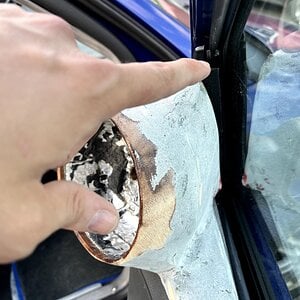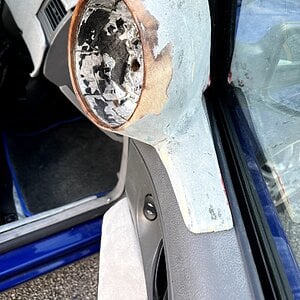You are using an out of date browser. It may not display this or other websites correctly.
You should upgrade or use an alternative browser.
You should upgrade or use an alternative browser.
Firewalker
CarAudio.com VIP
By using a DMM and the voltage method. Use the link below to figure out what it would be on the DMM and set the voltage on the amplifier accordingly.

 www.the12volt.com
www.the12volt.com

Ohm's Law Calculators and Formulas
Firewalker
CarAudio.com VIP
On the right use the voltage calculator. Take the RMS power of the speakers x 4 ohms and it will give you the voltage.
So say the for the sub amplifier 3,000 watts at 1 ohm would be 54.72 on the DMM for voltage.
For the 4 channel say the total RMS is 200 watts between both speakers, take 200 then 4 ohms would be 28.28 on the DMM. As Channel 1 should control the voltage for left and right front with channel 2 controlling rear left and right speakers. Or if you are using the front with components only then you put the tweeters on the front channels and the mid-bass on the rear channels. Works perfectly and you set the voltage on 1 for the tweeters and 2 for the mid-bass. Did mine that way for awhile always works.
FYI you set your head unit to 75% and make sure you are using a test tone as well to set the voltage on the amplifier. If the head unit has BT use a test tone generator on your phone and connect it that way. I set mine that way and it works or buy the test tone cd from SMD if you want.
So say the for the sub amplifier 3,000 watts at 1 ohm would be 54.72 on the DMM for voltage.
For the 4 channel say the total RMS is 200 watts between both speakers, take 200 then 4 ohms would be 28.28 on the DMM. As Channel 1 should control the voltage for left and right front with channel 2 controlling rear left and right speakers. Or if you are using the front with components only then you put the tweeters on the front channels and the mid-bass on the rear channels. Works perfectly and you set the voltage on 1 for the tweeters and 2 for the mid-bass. Did mine that way for awhile always works.
FYI you set your head unit to 75% and make sure you are using a test tone as well to set the voltage on the amplifier. If the head unit has BT use a test tone generator on your phone and connect it that way. I set mine that way and it works or buy the test tone cd from SMD if you want.
Last edited:
Water Bear
Senior VIP Member
The math is like this: Ohm's law is P (power) = V^2 (voltage squared) / R (impedance). (This is only true under some pretty strict assumptions, namely that you can represent your speaker as an RLC circuit. Let's not worry about this too much).
Without giving a science lesson on impedance, the point is that it depends on the frequency of alternating current. Your "4 ohm nominal" speakers won't measure 4 ohms on a DMM. We're going to assume that they present a 4 Ohm impedance at least some of the time during normal operation.
Soooo...hook your DMM up to your amp's speaker outs. Solve the equation sqrt(P * R) = V. Example: For a 100 watt speaker at 4 ohm, one channel should output sqrt(100 * 4) = 20 Volts. Set your head unit volume to whatever you tune at, turn up your gain until your DMM reads 20 V AC. Boom, you're done. Your amp will produce no more than 100 watts per speaker if you don't exceed tuning volume.
Without giving a science lesson on impedance, the point is that it depends on the frequency of alternating current. Your "4 ohm nominal" speakers won't measure 4 ohms on a DMM. We're going to assume that they present a 4 Ohm impedance at least some of the time during normal operation.
Soooo...hook your DMM up to your amp's speaker outs. Solve the equation sqrt(P * R) = V. Example: For a 100 watt speaker at 4 ohm, one channel should output sqrt(100 * 4) = 20 Volts. Set your head unit volume to whatever you tune at, turn up your gain until your DMM reads 20 V AC. Boom, you're done. Your amp will produce no more than 100 watts per speaker if you don't exceed tuning volume.
Firewalker
CarAudio.com VIP
Water Bear
Senior VIP Member
Is it that hard to plug P and R into the equation sqrt(P * R) and then turn a gain knob with a DMM? Well, you can't go wrong taking it to a shop. 
- Thread Starter
- #9
No it's not hard to turn knobs and read meters. But when this is something you have never done and you have thousands invested in a particular thing then you want someone else to be responsible for damaging it. Plus I want to get the DSP setup right. I have never dealt with those. The most technical I have ever gotten is to connect an oscilloscope to my equiment to set gains.Is it that hard to plug P and R into the equation sqrt(P * R) and then turn a gain knob with a DMM? Well, you can't go wrong taking it to a shop.
Water Bear
Senior VIP Member
I get where you're coming from. You don't need a DSP for this, any ol' DMM would do. Reading the AC voltage from your amp's speaker terminals is about the same level of difficulty as reading the AC voltage from a wall outlet in your house, so it's probably easier than you think, but I get it.No it's not hard to turn knobs and read meters. But when this is something you have never done and you have thousands invested in a particular thing then you want someone else to be responsible for damaging it. Plus I want to get the DSP setup right. I have never dealt with those. The most technical I have ever gotten is to connect an oscilloscope to my equiment to set gains.
HardofWhoring
Member
Like this:
Not at the speakers, remove the speaker wire, and test at the terminals. (The probes can be secured that way).
Not at the speakers, remove the speaker wire, and test at the terminals. (The probes can be secured that way).
HardofWhoring
Member
I'm a visual learner too, but it's pretty simple when you see it.
OP, I have a kenwood Excelon, and a DD1+. I have tested the output voltage on my head unit. On two of my excelon head units, the max rated voltage is achieved at 34 (out of a max of 35). The range up to 34 is .2v between adjustments. 34-35 is 10% more. (.4 and .5v). It does make a big difference. Also, you can clip from your head unit. If you use that DMM / AC voltage method to set your gain, if you are lower than your rated RMS wattage, then you are also below your rated THD. Your head unit can cause THD. Cheap head units can cause clipping below max volume. Even good head units can clip at max volume, because rated voltage output might be below max volume.
I would disagree with that. You're either cutting down your usable range, making your adjustments have more gap between each adjustment; or you're going to turn it up over where it was set, and then you're going to be sending a lot more wattage to your speakers. One or two below max volume seems more reasonable to me.On the right use the voltage calculator. Take the RMS power of the speakers x 4 ohms and it will give you the voltage.
So say the for the sub amplifier 3,000 watts at 1 ohm would be 54.72 on the DMM for voltage.
For the 4 channel say the total RMS is 200 watts between both speakers, take 200 then 4 ohms would be 28.28 on the DMM. As Channel 1 should control the voltage for left and right front with channel 2 controlling rear left and right speakers. Or if you are using the front with components only then you put the tweeters on the front channels and the mid-bass on the rear channels. Works perfectly and you set the voltage on 1 for the tweeters and 2 for the mid-bass. Did mine that way for awhile always works.
FYI you set your head unit to 75% and make sure you are using a test tone as well to set the voltage on the amplifier. If the head unit has BT use a test tone generator on your phone and connect it that way. I set mine that way and it works or buy the test tone cd from SMD if you want.
OP, I have a kenwood Excelon, and a DD1+. I have tested the output voltage on my head unit. On two of my excelon head units, the max rated voltage is achieved at 34 (out of a max of 35). The range up to 34 is .2v between adjustments. 34-35 is 10% more. (.4 and .5v). It does make a big difference. Also, you can clip from your head unit. If you use that DMM / AC voltage method to set your gain, if you are lower than your rated RMS wattage, then you are also below your rated THD. Your head unit can cause THD. Cheap head units can cause clipping below max volume. Even good head units can clip at max volume, because rated voltage output might be below max volume.
hispls 5,000+ posts
CarAudio.com Veteran
Which amp and which speakers? What crossover are you using? You may be fine so long as you never push the volume too hard.
Activity
No one is currently typing a reply...
Similar threads
Any alternator will outlive a boxer engine. I like my iraggi alternator.
- Started by ikpthegame
- Wiring, Electrical & Installation
- 2
- 627
I use Mechman
- Started by TeflonDonSubKing
- General Car Audio
- 7
- 1K
- 4
- 917
The correct answer is yes, you want both left and right so you get low end information from both channels. It is very common for recording...
- Started by AudioArchitech
- Wiring, Electrical & Installation
- 2
- 1K
Umm boats don't charge a battery? Where do you come up with that? That is one wrong answer flat out. Outboards can charge off the stator and some...
- Started by AngryPossum
- General Car Audio
- 5
- 1K
Latest topics
-
Does this amp/speaker combo work well for both sets of speakers?
- Started by kanihoncho
- Replies: 3
-
-
-
-


